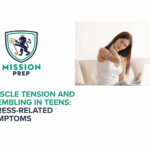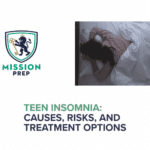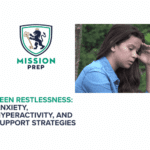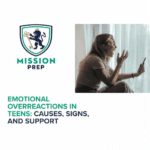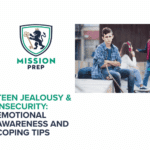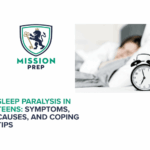Adjustment Disorders in Teenagers: What They Are & Support Options

Even the most resilient teenager can feel overwhelmed from time to time. Big life changes, such as a divorce or moving home, can quietly take a toll on their well-being. In fact, what sometimes can look like typical “teenage moodiness” or acting out after a major life transition may instead be a sign of something more serious: an adjustment disorder.
Adjustment disorders in teenagers are mental health conditions that can develop after stressful events like a life change, resulting in emotional reactions much greater than those one would normally expect.
If you think your teen may be struggling with an adjustment disorder, talking to a mental health professional can ensure they get the support they need to readjust. This page can also help you better understand adjustment disorders in teenagers by covering:
- What an adjustment disorder is
- Causes of adjustment disorder in teenagers
- Common symptoms of adjustment disorder to look for
- How adjustment disorder differs from depression
- The diagnosis process
- Effective treatment options for teens with adjustment disorder
- Where to seek professional support

What Is Adjustment Disorder in Teenagers?
The symptoms of adjustment disorder can vary subtly between adults and teenagers. For instance, adults tend to experience more emotional symptoms, such as depression. In comparison, adolescents often show more behavioral signs, such as acting out defiantly or risk-taking.2 Yet, regardless of how they show them, adjustment disorder emotional and behavioral symptoms can significantly impact a teen’s life, potentially affecting school work, friendships, family dynamics, and overall well-being.
It may be helpful to clarify the difference between a “normal” stress response and an adjustment disorder. A typical stress response may include temporarily feeling anxious or overwhelmed until the stressful event is over. When the event passes, people tend to be able to adjust their thoughts and feelings and return to normal ways of functioning.
In contrast, someone with an adjustment disorder may become stuck in a stress response, finding it difficult to return to regular functioning even once the cause of stress has passed.
Unfortunately, adjustment disorders are quite common in children and adolescents due to the many changes they often encounter during childhood. In fact, research and data show that 5-35% of people in general experience an adjustment disorder.5 The potential causes of adjustment disorder in teens are explored in more detail in the next section.
Causes of Adjustment Disorder in Adolescents
Before we get to these sources, it’s good to note that many children and adolescents may experience intensely stressful events without finding them overly challenging. This suggests that genetics, specific experiences, and temperament may contribute to a teen’s risk of developing an adjustment disorder.4
Some examples of stressors in emotional adjustment disorder teenagers include:3,5
Parents divorcing- Moving home
- Loss of a loved one or a pet
- Relationship breakup
- Sexual identity concerns
- Difficulties in school
- Academic pressure
- Problems with peers
- Bullying
- Starting a new school
- Developing a medical illness
- Living in an unsafe neighborhood
- Trauma
- Natural disasters, such as earthquakes
- War
If your child has recently experienced any of the above stressors and is acting out of their usual character, the next section may be particularly useful. It discusses symptoms that stress related adjustment disorder youth may experience, allowing you to pinpoint whether extra support may be needed to help your child recover.
Adolescent Adjustment Disorder Symptoms
Adjustment disorders can also come in six specific types. These are adjustment disorders with (1) depressed mood, (2) anxiety, (3) anxiety and depressed mood, (4) disturbance of conduct, (5) mixed disturbance of emotions and conduct, and (6) unspecified. Each of these six subtypes has its own unique symptoms, which you can read more about in our guide Types of Adjustment Disorder in Teens.
Although behavioral signs are most notable in teens, symptoms may manifest in several ways depending on the subtype, including:1,3,4
Behavioral Signs of Adjustment Disorder:
- Tearfulness
- Acting defiantly
- Destroying property or belongings
- Fighting
- Impulsive or reckless behavior
- Avoiding or skipping school
- Drop in academic performance
- Withdrawing from family and friends
- Disregarding their responsibilities
- Stopping activities they used to enjoy
- Self-harm
Physical Signs of Adjustment Disorder:
- Feeling tired
- Trouble sleeping
- Unexplained aches and pains (such as headaches or stomach aches)
- Palpitations (feeling like your heart skips a beat)
- Feeling “jittery”
- Appetite changes
Emotional Signs of Adjustment Disorder:
- Agitation
- Anxiety
- Feeling nervous
- Depression
- Feeling hopeless
- Worry
Cognitive Signs of Adjustment Disorder:
- Difficulty concentrating
- Poor decision-making skills
- Memory problems
As may be evident based on these symptoms, adjustment disorder can have a serious impact on a teen’s daily functioning. Plus, if symptoms continue or treatment is not sought for this condition, there may be harmful consequences, such as the school struggles adjustment disorder teens often face. These issues may look like a sudden drop in academic performance or even leaving school entirely. Additionally, a teen may resort to unhealthy coping mechanisms in an attempt to alleviate their distress, such as self-harm or contemplating suicide.
If you’re aware that your child has (or is) facing identifiable stressors and recognize some of these symptoms, they may be struggling with an adjustment disorder. However, it’s good to be aware that some of the symptoms of adjustment disorders can overlap with those of other mental health conditions, such as depression, occasionally resulting in misdiagnosis. The following sections cover the similarities and differences between these two conditions before explaining the diagnosis process.
Teen Adjustment Disorder vs Depression
For some teens, the symptoms of adjustment disorder may look like those of depression. For instance, adolescents with adjustment disorder may experience a low mood, tearfulness, tiredness, hopelessness, or loss of interest in activities they used to enjoy – which are also signs of depression. Yet, despite this overlap of symptoms, it’s crucial to know that adjustment disorder is not the same as depression.
There are two key differences separating adjustment disorders and depression. The first is that adjustment disorder in teenagers tends to last no more than six months, whereas depression can be a lifelong condition for many people. The second is that adjustment disorders have a clearly identifiable cause: a stressor triggering the disorder. In contrast, depression may develop without a clear trigger.
Being able to differentiate between the two conditions is essential for correct diagnosis and, subsequently, receiving the most appropriate treatment. But how can someone go about getting an adjustment disorder diagnosis? The next section walks you through this process so that you can feel confident and prepared for the journey.
Getting an Adjustment Disorder Diagnosis in Teens
A mental health professional, such as a psychologist or psychiatrist, will use the diagnostic criteria specified in the Diagnostic and Statistical Manual of Mental Disorders (DSM-5) to make a diagnosis. During the assessment process, they may ask you to share examples of your teen’s behavior, life events, emotions, and potential stressors to assist with the diagnosis.
For example, based on the criteria in DSM-5 for adjustment disorder, they may ask questions around whether your child has:6
Developed emotional or behavioral symptoms within three months of the start of a stressful event- Experienced clinically significant symptoms, meaning they either:
- Cause distress out of proportion to the severity of the stressor
- Cause significant impairment in social, work, or home life
- Symptoms that do not meet criteria for another mental disorder, nor a worsening pre-existing mental health condition
- Symptoms that do not represent part of a normal grieving process
If your teen is diagnosed with an adjustment disorder, they will be recommended appropriate treatment to help improve their symptoms. The different forms of treatment for adjustment disorder in teens are explained in the next section.
Treatment for Adjustment Disorder in Teens
The primary treatment and support for teen adjustment disorder often comes in the form of talk therapy. Fortunately, due to the typically time-limited nature of the condition, many people find that they only need brief treatment for adjustment disorder. However, those with ongoing stress may benefit from a longer course of treatment.
The following sections discuss medication and therapy for adjustment disorder, along with suggestions for improving symptoms.
Therapy for Adjustment Disorder
Psychotherapy is the main treatment for adjustment disorders. By engaging with adjustment disorder therapy young adults can receive emotional support, understand why they were so intensely affected, learn stress management skills, and begin returning to their typical routines. Cognitive behavioral therapy (CBT) may be particularly effective for treating adjustment disorders due to its ability to alleviate anxiety. However, there is currently little guidance or evidence as to which therapeutic approach is the most effective.7,8
Additionally, therapy can be carried out as individual (one-to-one), group, or family therapy. Family therapy may be especially beneficial if the stressor involves a family event. This is because it often focuses on making changes needed to minimize stressors, such as improving communication and family interactions.3
Medicines Used to Treat Adjustment Disorder
Depending on your child’s symptoms, medications may be used in treatment alongside talk therapy. For example, antidepressants or anti-anxiety medications may be prescribed to ease symptoms of depression or anxiety.4 Alternatively, if sleep is an issue, then they may be recommended a sleep aid.
However, these medications only help certain symptoms, rather than addressing the core issues. For this reason, they are typically not prescribed as a treatment for adjustment disorder on their own – therapy is usually required to get to the root of the problem. Plus, as with all medications, there is the possibility of side effects, so your healthcare provider will carefully weigh up the pros and cons before prescribing medication to your teen.
Lifestyle Changes
Making positive changes to daily routines can help teens reduce stress levels and adapt to change in healthier ways. Some suggestions for introducing positive changes include:
Engaging in self-care: Self-care can help a person de-stress and redirect their focus to things that make them feel good.9 For example, self-care may look like reading a book, taking a bath, writing in a journal, or spending some time on hobbies.- Keeping a healthy lifestyle: Eating a healthy, balanced diet and doing regular physical activity can boost physical and mental health as well as reduce stress.10
- Building a support system: Talking with friends and family can be a help when facing stress and struggles. Try to build a support system of trusted people around you so that you have others who can help lift you up when you’re feeling down.
- Practicing mindfulness: Mindfulness is known to help people manage their stress more effectively.11 If you want to learn more about mindfulness, check out our guide, Mindfulness and Meditation for Teens.
If you’re concerned that your teen may be struggling with an adjustment disorder, take heart in the fact that it is a very treatable condition. With the right support, your child can work toward becoming their usual self once more and build extra resilience along the way.

Find Support for Your Teen With Mission Prep
Seeing your teen struggle with adjustment disorder can be highly distressing, but with the right support, they can find emotional balance, rebuild their confidence, and move forward with more resilience. And we’re here to help them through this process.
Here at Mission Prep, we specialize in helping young adults and adolescents overcome their mental health challenges. Therefore, when difficult life transitions take a toll, our experienced therapists understand just how to help teens readjust and heal through care that is individualized and personally effective.
Reach out to us today and schedule a free, confidential consultation to find out how we can help your teen – and family – find balance and calm.
References
- Cleveland Clinic. (2025, August 27). Adjustment disorders. https://my.clevelandclinic.org/health/diseases/21760-adjustment-disorder
- Boston Children’s Hospital. (n.d.). Adjustment Disorders. Retrieved September 24, 2025, from https://www.childrenshospital.org/conditions/adjustment-disorders
- Johns Hopkins Medicine. (2021, August 8). Adjustment disorders. https://www.hopkinsmedicine.org/health/conditions-and-diseases/adjustment-disorders
- Mayo Clinic. (2023, July 6). Adjustment disorders – Symptoms and causes. https://www.mayoclinic.org/diseases-conditions/adjustment-disorders/symptoms-causes/syc-20355224
- Alvarado, G. L. (2021). Adjustment disorder in the pediatric population. Pediatric Medicine, 5, 19. https://doi.org/10.21037/pm-20-76
- American Psychiatric Association. (2013). Diagnostic and statistical manual of mental disorders (5th ed.). https://doi.org/10.1176/appi.books.9780890425596
- O’Donnell, M. L., Agathos, J. A., Metcalf, O., Gibson, K., & Lau, W. (2019). Adjustment Disorder: current developments and future directions. International Journal of Environmental Research and Public Health, 16(14), 2537. https://doi.org/10.3390/ijerph16142537
- Zelviene, P., & Kazlauskas, E. (2018). Adjustment disorder: current perspectives. Neuropsychiatric Disease and Treatment, Volume 14, 375–381. https://doi.org/10.2147/ndt.s121072
- Town, R., Hayes, D., March, A., Fonagy, P., & Stapley, E. (2023). Self-management, self-care, and self-help in adolescents with emotional problems: A scoping review. European Child & Adolescent Psychiatry, 33(9), 2929. https://doi.org/10.1007/s00787-022-02134-z
- Harvard Health Publishing. (2020, July 7). Exercising to relax. https://www.health.harvard.edu/staying-healthy/exercising-to-relax
- Khoury, B., Lecomte, T., Fortin, G., Masse, M., Therien, P., Bouchard, V., Chapleau, M., Paquin, K., & Hofmann, S. G. (2013). Mindfulness-based therapy: A comprehensive meta-analysis. Clinical Psychology Review, 33(6), 763-771. https://doi.org/10.1016/j.cpr.2013.05.005

